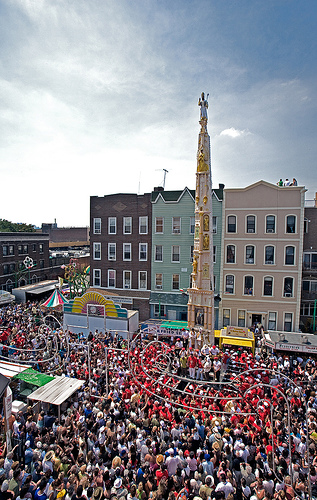
Today marks the Feast of Our Lady of Mount Carmel, and some parishes around the world are also celebrating with the giglio.
Whatzzat?
In Italian Williamsburg, Brooklyn, the residents of the community look forward to the annual Giglio Feast held every July. Since 1903, when the Nolani immigrants first held their transplanted feast in this Brooklyn neighborhood, this festa has attempted to maintain many of the traditions from the Mezzogiorno, while adjusting to the new culture in America and accommodating the pressure to change.
The Nolani, who settled in this section of Brooklyn in the 1880s.as the flood tide of southern Italian immigration washed upon the American shores.were eager to pay homage to their patron saint, San Paolino (the Catholic Church prefers the Latin pronunciation, Saint Paulinus) However, there were more pressing tasks to accomplish first. Along with their co-religionists, the Italian residents contributed to the building of the original Our Lady of Mount Carmel Church ( at North 8th Street and Union Avenue). The devotion of all southern Italians to the Madonna is legend, but their adoration of la Madonna Della Carmine (Our Lady of Mount Carmel) is of the highest order. As important as the Catholic Church was to these people, they still desired to pay homage to San Paolino. It is important to point out that the saints belonged, in the eyes of the peasant immigrant, more to their town or village, than to the institutional church. Thus, in the case of honoring SanPaolino, the responsibility in the United States fell not upon their parish, but to a mutual aid society which had been formed.Società M.S. San Paolino. The preferred method of meeting this obligation was to hold an annual feast in honor of the saint in question. From 1903 to 1954 , the Società M.S. San Paolino took responsibility for the operation of this annual feast in Williamsburg, Brooklyn.
This feast, which has been taking place in Brooklyn for over 100 years, commemorates an extraordinary bit of southern Italian history which culminated in the canonization of an erstwhile bishop of the small city of Nola. Not even Catholic until his thirty-seventh year, Paulinus was destined to become a renowned religious hero of that region. Though he was to serve as Bishop of Nola from 409 AD to 431 AD, it was an alleged episode, that took place shortly after his elevation to bishop, for which the Nolani hold him in such high regard.
The story, which is passed on through the generations on both sides of the Atlantic, is that around 410 AD, North African pirates overran the town of Nola. In the chaos, Bishop Paolino was able to flee into the countryside with some of the children. Upon his return, Paolino learned, from a sobbing widow that many of the young men, her son included, had been abducted into slavery. Moved to compassion, Paolino offered himself in exchange for the boy and was ferried off, a prisoner of the brigands. While in North Africa, word of the courage and self-sacrifice of Paolino spread and became known to a certain Turkish sultan. Taken with the tale of altruism, the sultan intervened, negotiating for the freedom of this holy man. Through the sultan ‘s efforts, Paolino and his paesani, were freed.
Overjoyed by his safe return, the entire town greeted him carrying lilies, symbolic of love and purity. That joyous homecoming jubilee is considered the very first observance of what would develop into an annual sacred event. Through the years, various trade guilds (farmer(ortolamo), butcher(beccaio), tailor(sarto), breadmaker(panettiere), blacksmith(fabbra), cobblers(calzolaio), deli merchants(salumiere), and wine makers(bettoliere) ) began to compete to produce the most sensational display of lilies. Over time, these displays became more flamboyant.
Today, although still called lilies (gigli), they have evolved into huge flower-laden steeples of wood, 50 feet or more in height. In Nola, these gigli structures and a boat (la barca) are carried through the streets on the shoulders of hundreds of men, in remembrance of the return of Paolino to Nola. The atmosphere is quite competitive and each guild hires the best lifters they can secure, because the carrying of the gigli is judged. Creativity of construction and musical accompaniment is also scrutinized even after the formal competition ends, and the men of Nola carry and dance the gigli throughout the night.
This is the tradition that was transplanted to Brooklyn, New York by the Nolani immigrants. It would be embraced stateside by all of those Italians who had emigrated from towns and villages surrounding Nola. World War II diverted the community’s energies (and men) in another direction and the Giglio Feast was discontinued temporarily. It would not be until June 22,1949 (the feast day of San Paolino) that this feast was reinstituted.
There’s much more at the link, including a detailed description of what goes on.
Yo! Wanna go? We did two features on the giglio in Brooklyn last summer on “Currents.”
Here’s a look at some of the festivities.
Gotta love Brooklyn.

